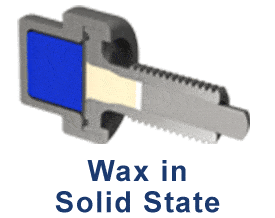Thermostatic Technology
Thermal actuators convert a temperature change into mechanical motion. The phase-change technology utilized in our thermal control valves has been used dating back to the early 1900s, to change phase from solid-to-liquid, on increasing temperature, and from liquid-to-solid, on decreasing temperature to produce a usable stroke.
The unique quality of paraffin wax, which sits at the heart of each of our TCVs, is its predictability. When exposed to variations in temperature within its active range (typically 10°F), the performance of the thermostatic element can be predicted with a relatively high degree of accuracy, which is why thermal actuators are used as primary reference standards by ASTM for instrument calibration.
What’s the working principle of a temperature control valve?
Overall, the working principle of a temperature control valve involves the expansion and compression of a thermal-sensitive material in response to changes in temperature. This expansion then triggers the internal mechanisms of the valve, causing it to adjust its position and control the flow of fluid.
Here is a breakdown of how our temperature control valve works:
At the heart of all our valves is a thermal actuator that contains our patented Thermoloid® paraffin wax element. As temperature increases above the melting point of the Thermoloid® material, it expands in volume and pushes against a diaphragm, which in turn pushes on a piston.
In its “hot position,” the piston acts as a valve stem, opening or closing the valve. As the Thermoloid® material cools below its melting point, it compresses, and a spring returns the piston and diaphragm to the “cold position.”
The phase change, resulting in a significant volume change, produces motion over a narrow, highly predictable temperature range. The temperature range at which the phase change occurs can vary depending on the chemical composition of the Thermoloid® material used.
Our Thermoloid® material operates at temperatures ranging from 15°F to 300°F (-9.44°C to 149°C). Because of the gradual transition from solid-to-liquid of this Thermoloid® material, these valves act more like modulating valves than quick opening/closing valves.
Our direct-acting valves are designed to be open when the wax is in its solid state or the “cold position,” while reverse-acting valves are open when the wax is in its liquid state or the “hot position.”
Temperature Control Valves and Systems
As a leader in self-actuated temperature control solutions, ThermOmegaTech® prides itself on its high-quality manufacturing process, problem-solving approach, and innovative engineering techniques to design and manufacture reliable, automated, self-powered TCVs and thermal actuators. Available in a variety of sizes and configurations, our products can be utilized in limitless applications. Below are some applications where our valves have been used.
- Balancing Valves for Domestic Hot Water Systems – CircuitSolver
- Cooling Water Control Valves – HAT/RA, HAT/RA-LP, TV/HAT-RA, & TV/HAT-RA-LP
- Drain Tempering Valves – DTV
- Freeze Protection Valves – HAT/FP & IC/FP
- Freeze Protection Valves for Locomotives – GURU
- Freeze Protection Valves for Passenger Rail Cars – GURU PC
- Glycol Tracing Control Valve – HAT & TV/HAT
- High-Temperature Shut Off Valves – HST, HAT, & TV/HAT
- Instrumentation Protection Valves – TV/SC-A, TV/HAT, TV/SC-I, TV/SC-IR, & ITCH kit
- Mechanical Seal Flush Valves – EcoFlow
- Mixing and Diverting Valves – M/D
- Pump Thermal Relief Valves – ECONO/HAT-RA & HAT/RA-HP
- Sample Cooler Temperature Control Valves – HST, US/S-XR, & TV/US-XR
- Scald Protection Valves – HAT/SP & IC/SP
- Steam Tracing Control Valves – TV/SC-A, US/S-X, & TV/US-X
- Steam Trap Valves – HAT & TV/HAT
- Tepid Water Delivery Systems – Therm-O-Mix Station, Therm-O-Mix WWM, & ESS Water Heater
- Thermal Bypass Valves – M/D
- Washdown Stations and Supplies – STVM, HCX, and HCS Stations
Sales and Engineering Support
Visit our Interactive Applications Guide to see how our thermostatic valves can benefit your operation.
Our self-operating thermostatic technology is an elegant solution, proven highly reliable in various applications, whether in one of our off-the-shelf products or a custom solution designed by our in-house engineering team to meet a customer’s unique needs.
Contact us to discuss your projects’ requirements for overall size, spring strength, weight ratios, temperature ranges, flow rates, threads, materials., etc. Cartridges or actuators can also be modified to integrate into custom valve bodies or pre-existing/custom manifolds.
